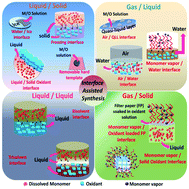Interface-assisted synthesis: a gateway to effective nanostructure tuning of conducting polymers
Abstract
The interface-assisted polymerization technique can be viewed as a powerful emerging tool for the synthesis of conducting polymers (CPs) on a large scale. Contrary to other bulk or single-phase polymerization techniques, interface-assisted synthesis strategies offer effective nanostructure control in a confined two-dimensional (2-D) space. This review focuses on the types of interfaces, mechanism at the interface, advantages and future perspectives of the interfacial polymerization in comparison to conventional polymerization techniques. Hence, the primary focus is on briefing the different types of the chemical methods of polymerization, followed by uniqueness in the reaction dynamics of interface polymerization. The classification of interfaces into four types (liquid/solid, gas/liquid, liquid/liquid, and gas/solid) is based on the versatility and underlying mechanistic pathway of the polymerization of each type. The role of interface in tuning the nanostructure of CPs and the performance evaluation of pristine CPs based on the electrical conductivity are also discussed. Finally, the future outlook of this emerging field is discussed and proposed in detail through some multifunctional applications of synthesized conducting polymers.

- This article is part of the themed collection: Celebrating International Women’s Day: Women in Nanoscience


 Please wait while we load your content...
Please wait while we load your content...